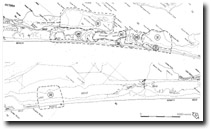GL27 (8422) Mullacky Lagoon ("Moss Ball" Lake)
|
This information has been developed from the publications:
|
| Location: | 690990. Two kilometres east of Ocean Grange, on shore of Bunga Arm. | |
Abstract: | Lagoon and swamp isolated by spit growth. | |
Access: | Boat in Bunga Arm. | |
Ownership: | Crown land. | |
Geomorphology:: | The southern shoreline of Bunga Arm has been extensively modified by washover and spit growth. At Mullacky Lagoon, spit growth towards the north-east has outflanked and enclosed a small embayment which has become largely infilled by swamp. Initially a Phragmites reed swamp, the increasing salinity of Bunga Arm has converted much of this swamp to a Salicornia and Juncus marsh. Small, round to oval spheres, which appear occasionally and float on the water are known locally as ‘moss balls’. They are comprised of densely interwoven branches of a green algae, Cladophora echinus. | |
Significance: | Regional. This is a clear example of the processes of shoreline reclamation by spit growth and swamp development. | |
Management: | Grazing, or other vegetation disturbance on the outer barrier should be prohibited as this may mobilise sand dunes that will infill the lake. | |



